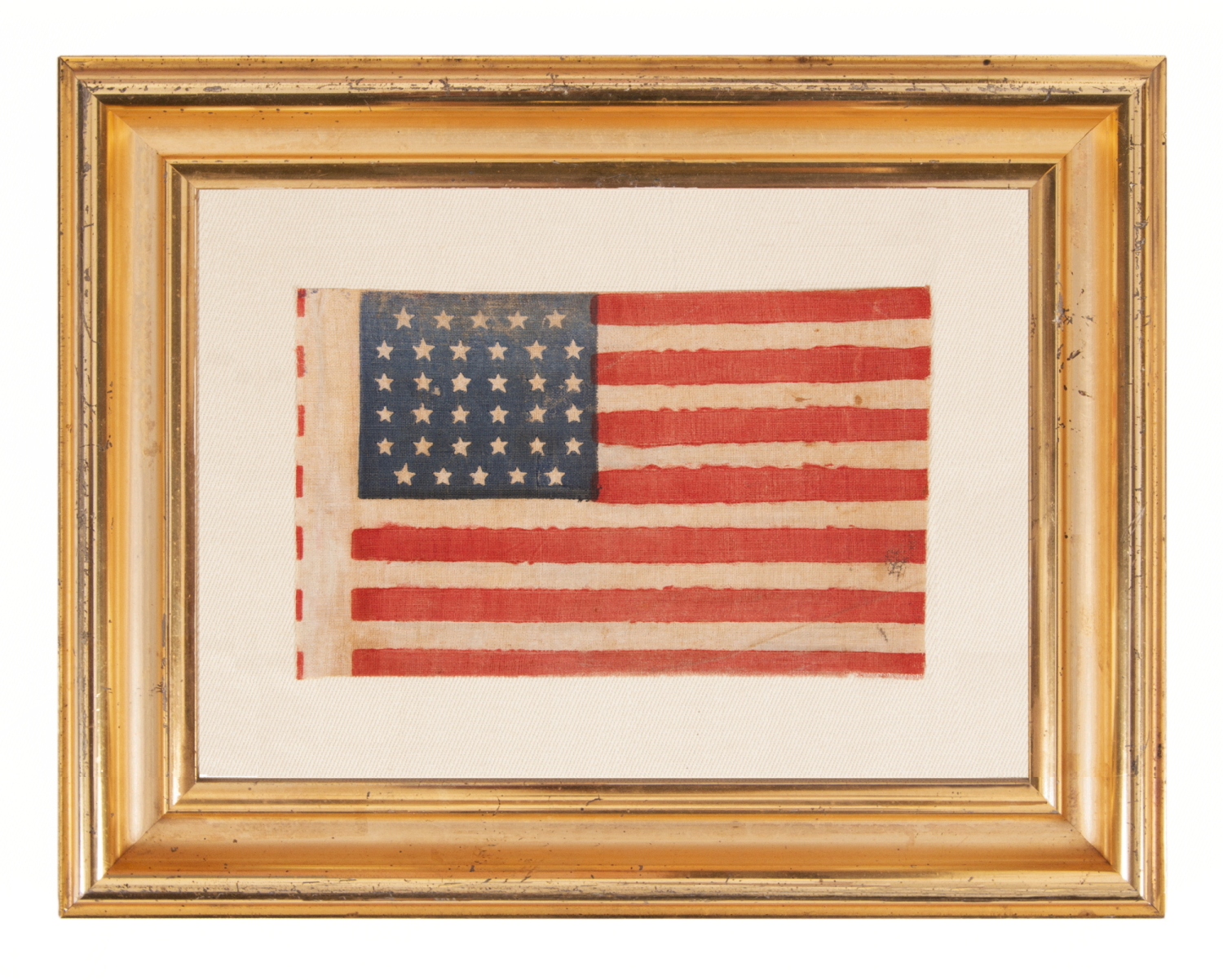


| 34 STAR ANTIQUE AMERICAN FLAG WITH A LINEAL ARRANGEMENT THAT I HAVE TERMED "GLOBAL ROWS, WITH EXCEPTIONAL COLOR AND CRUDE YET BEAUTIFUL FEATURES, OPENING TWO YEARS OF THE CIVIL WAR, 1861-63, KANSAS STATEHOOD |
|
| Web ID: | 34j-1025 |
| Available: | In Stock |
| Frame Size (H x L): | Approx. 13" x 16" |
| Flag Size (H x L): | 5.25" x 8.5" |
| Description: | |
| 34 star American parade flag, printed on plain weave cotton. Kansas was admitted into the Union as the 34th state on January 29th, 1861, about 2 ½ months before the Confederate assault on Fort Sumter that marked the beginning of the Civil War. The 34th star was officially added on July 4th of that year, but most flag makers would have added a 34th star with the addition of Kansas in January. The star count remained official until July 4th, 1863, and 34 star flags would have generally been produced until the addition of West Virginia in June of that year. 34 star parade flags are extremely scarce. Prior to the Civil War, Americans did not employ the flag in many of the ways we do today. Private citizens generally did not fly flags from their porches or wave hand-held examples, like this one, at parades and rallies. Flags were primarily a tool of the military--particularly the U.S. Navy. It wasn't until Confederate forces fired upon Fort Sumter that a surge of patriotism caused a great increase in the making and consumption of the Stars & Stripes by the general public. It was then that flag-makers began to produce them in significant quantities for the first time. This flag would have been among some of the first made for that purpose. The stars are arranged in justified lineal rows of 5-6-6-6-6-5. This results in secondary configuration that I have termed to as “global rows”, because the pattern somewhat resembles a global map, with a vertical oval of stars in the center and parentheses to either side, the overall presentation of which resembles longitudinal lines. This can also be viewed as two vertically-oriented, elliptical arrangements, with a singe star between them at the center of the top and bottom rows. Note the wide and crudely printed burnt orange stripes, with wavy edges and inconsistent placement, which adds a great measure of folk quality to the flag’s presentation, as does the gradient application of pigment in the blue canton. Also note the small segment of stripes from the flag that was adjacent to this one on the bolt, present along the hoist. All-in-all, a wonderful example of the Civil War period with great colors and interesting characteristics. Mounting: The flag was mounted and framed within our own conservation department, which is led by expert staff. We take great care in the mounting and preservation of flags and have framed thousands of examples. The gilded American frame dates to the period between 1830 and the 1850's. The background is 100% cotton hemp fabric, ivory in color, with a twill weave. Spacers keep the textile away from the glazing, which is U.V. protective glass. Condition: In addition to the crude nature of the printing described above and the inconsistent application of the blue, there is modest soiling throughout, with a few moderate spots of rust as well as black colored staining toward the fly end. Many of my clients prefer early flags to show their age and history of use. |
|
| Video: | |
| Collector Level: | Intermediate-Level Collectors and Special Gifts |
| Flag Type: | Parade flag |
| Star Count: | 34 |
| Earliest Date of Origin: | 1861 |
| Latest Date of Origin: | 1863 |
| State/Affiliation: | Kansas |
| War Association: | 1861-1865 Civil War |
| Price: | Please call (717) 676-0545 or (717) 502-1281 |
| E-mail: | info@jeffbridgman.com |
 |
|